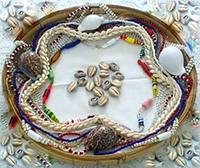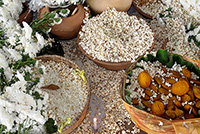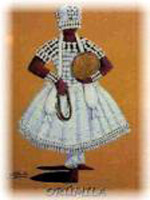Initiation
The process in which the neophyte goes through to establish stronger bonds with his head Orixá, resulting in a ODU (a way) more easily recognized by the initiate from this moment on.
Possibilities for victory improve over the obstacles and as a result of this sum of forces (initiation), the YAWO (initiate) will be better protected and defended by his Orixá.
The ritualistic washing of the sacred necklace and the BORI are a obligatory part of the initiation, for a more intimate participation in Candomblé requires passage through the intermediary steps.
But we should always remember, that this ritualistic washing and the “feeding of the head Orixá” are part of the ceremonial sequence of the initiation, and that it’s infinitely richer, more complex, once that, through it, the incorporation of candomblé becomes even stronger.
GAME THE BÚZIOS

This is an instrument of communication between the Babalorixá and the Orixás.
It’s through it that the orixás manifest their warnings of the individual’s life, what has to be ritualistically done (ebó, bori, offerings, and placements) for his/her harmonization.
Finding who your head orixá is, the restrictions, where to take care will be revealed with the movements of the búzios.
ORI = HEAD
ORI RERE = lucky ORI = lucky head
ORI BURUKU = Unlucky ORI = unlucky head
ORI INU = “Inner Head”
It’s ORINU that manages the physical head of man.
It’s the most important Orixá of the human being, for he’s UNIQUE, every person has his own.
It is he who knows and is connected to the destiny of each individual, knows and understands your restricitions, your weaknesses, your potential.
It’s ORI who makes possible the communication of the individual with his own Orixá, striving for, through the rituals of EBÓ, BORI and initiation the greatest harmony possible within humans on earth; creating better possibilities in all aspects of life.
The maintenance of this new state depends on the continuity of the offerings.
BORI
BORI is the ritual that harmonizes ORI, allowing for the transformation of ” ORI BURUKU” in “ORI RERE”.
It’s through the Búzios that the Babalorixá receives instructions for this ritualistic act (BORI) that will provide not only a change of luck but its maintenance as well.
It’s the BORI that diminishes anxiety, fear, pain and sadness bringing hope, joy and harmony.
This way, BORI is one of the most important offerings that cares for the well-being of the individual in Candomblé.
The Bori Ritual is complex and serious so it’s vital the person performing it has vast knowledge and respect for the Ori and human evolution. Ori is the most important Orixá in the life of a man, for without it man does not exist. Ori, means literally “head”and is mistically the first Orixá to be worshipped. He is the bearer of human destiny.
Bori ritual of any beginner’s process is independent of the others Orixas cults. His objective is to feed the Ori. It does not matter the sex, race, profession, age, and social level of the person. This ritual seeks equilibrium throw the Ori action, the driver of personal destiny. Many times the Bori ritual occurs with the objective to protect against the bad things in the way of someone life, which does not means that throwing out the unpleasant any other unpleasantness will not happen. In this way, the Bori ritual has not any deadline; there is not determinate frequency (annual, monthly etc) it must be repeated always that seems to be done.
In the divinatory game, the Odu is manifested and throw Odu is expressed the bori necessity and indicates which materials must be used. There are two kinds of Bori:
(1) The one, which is, consider pre requisite to one initiation, it means, first feed the Ori, personal divinity, and then, follow the other Orixas.
(2) The one which has the function to solve a problem, which overwhelm the person throw the food of his or her Ori. In this case it is not necessary the Ori.
The local most appropriate to have this ritual is the priest home. The priest must have good sense of guardness. If the Bori will be followed by eje, it is recommended a rest and protection because the Ori which has been venerated must not receive the sun energy neither the night. The rest avoid that “the shadow” of the one who passed throw the Bori be stepped.
The priest have to know that during the ritual the person can be in trance only when his or her Orixa will be louver. The priest must know the finality and the meaning of each material which has been using. Omi and Obi, for instance, they are elements necessary for this ritual. Omi, the water, represents the abundant peace and fertility. And Obi is used as solve the furiousity of diversity, and also to feed and be agreeable to the divinities.
Throw the Odu in the divinatory game will determine which the material must be used in the Bori. This material can be from glass of water in the Bori or a large offer to the divinities in the Obi.
The most appropriate location for this ritual is the Babalorixá’s house. If the Bori is accompanied by eje, retiring for rest and protection is recommended. This retiring also avoids that the shadow of the individual who went through the Bori is stepped on. The Babalorixá must also know that the individual is only allowed to get into a trance when his Orixá is worshipped. He should know the purpose and significance of the material he uses in the ritual. Omi and Obi for example, are indispensable elements in this ritual. Omi, the water represents peace, abundance and fertility while obi is used to placate the fury of adversities, to feed and please the Deities.
The Buzios will determine through the Odu what material is to be used that can range from just a glass of water to very large offerings.
Offerings

The OFFERINGS are the “food” of orixás, that are prepared by the “daughters” of the Orixá.
These OFFERINGS reach even those not initiated, to receive the strength of the Orixás.
Each Orixá has his own OFFERINGS.
The offers have as a goal to promote the encounter. To establish the communication, to promote between the man with the orixas. The offer is the complement the divinatory game which we can know what, how, when and where prepare the offer to the Divinities. The dreams and intuition is also the path to attract the orixas protection.
The offers made according to the rules of cult tradition to the Orixas. They are made in the following circumstances:1- When the Ifá game (buzios, opele, ikin, etc) drive to consultant or the beginner to make the offer.
2- When the dream or intuition drive in that way.
3- According to the cyclic rhythm of the offer such as celebretation as know as ose, which can be made on a gaps of 5, 7, 11, 21 or 30 days. The time gaps are recommended by the Orixás.
4- Annually, the during the ceremony called Odun Orisa, which the finality is to celebrate the Orixas. O Odun Orisa can be related to individual or collective.
5- As a from of thanks for a reached grace
Evidentially, the orixas preferences must be primordially respected in order to obtain the Axe and those preferences include food, oriki, adura, orin, instruments, symbols, colours, vestments etc.
It is important remember that the Orixas benefit the engaged and non-engaged in the cult. It is extremely important the physic presence of the offering person, exceptionally the person is ill, traveling etc.
The offers are mineral, vegetal and animal origin. It is the combination of these three elements, associated to evocation (oriki), pray (adura) and singing (orin) which make possible the divinity attraction power that are in the nature for wellbeing of humankind. They effect are preventive, therapeutic and attractive.
An example of offer of mineral nature is the water – omi – used to prepare the alimentation of the orixas. The water has an uncontested vital power. Examples of offer of vegetal nature are obi and orobo, fundamental food for the divinities. Leaves and roots consecrated the orixas, they must be observed in order to adequate each leave or root to the orixas. The offers of animal nature also must be made according to divinity preference. Each quality and quantity are indicated in divinatory game. When are related to ebo, many times the Odu itself
We insisted that the offers must be request through the orixas by divinatory game and also through the personal desire to please the orixa. It is never a sacerdotal imposition.
The offers also can be consider as a food source for the orixas. We clarify the orixas symbols are associated to mineral, vegetal and animal elements, elements of nature, as the Orixa is Nature.
ODU
ODU (individual path) is revealed to the initiate after initiation rituals.
And He also reveals all your taboos, Orixás to which the initiate is linked to, it is He who gives your path, and code of conduct in life.
There are 16 main ODUS that branch out in 256.
ODU can be called individual sign.
inside every ODU are the ITAN (myth , History).
EBÓ
Is a ritual that helps that maintenance of your spiritual defenses. It is a ritual to give the individual the strength for him to face his difficulties. It’s important for the Babalorixá to stress that this is a complementary resource.
When an EBÓ is performed, there is a significant replenishment do of the individual’s energy, provoking a visible improvement in personal harmony and vitality, both physically and emotionally.
EBÓ is a mechanism to draw out the negative energy and keep it away. The Ebo is only favorable for those who perform it. Those who ignore it gain no benefits.
ORUMILÁ E IFÁ

Cosmos, is the retainer of the individual destiny knowledge.
Extremely primordial Deity in the hierarchy of Candomblé, Orumilá Baba Ifá. Understand there is an intrinsic relationship between Ifá with oracle divination practices and Orumilá as a supreme deity that witnessed the creation of the world by obatala and oduduwa, and everything that exists in it.
IFÁ, that witnessed individual destiny, is who knows the human being still in emi (spirit); accepted what was lived on earth (individual odu ), and therefore, is the one who knows each one’s story the most.
In the divination practices for Ifá, the odus describe the history of the world, nature and humanity. It describes its relationships, emotions and everything since the creation of the world and the arrival of humans to it.
It’s Ifa who describes us this, indicating the liturgical practices, teaching and explainig the DOs and DON’Ts and even which Orixás should be worshipped.
He is the great tutor and retainer of the liturgical knowledge of Candomblé.
Ifá has many names: elere ipin, the witness of destiny, that who postpones death, little great man, the wise…
His relation with Exu is very narrow, because he is the messenger of Orixás and Ifá.
To Ifá, everyone has their own destiny, being that individuality in Candomblé is very respected… Each one has his own path, although the worship of the Orixás are done collectively.
The practice of opele ifa or “coquinhos do dendezeiro” (“little nuts of dedezeiro”) is restricted to babalawos (men only), while búzios to babalorixás or iyalorixás (men and women).


